2021 MERCEDES-BENZ CLA COUPE weight
[x] Cancel search: weightPage 48 of 430
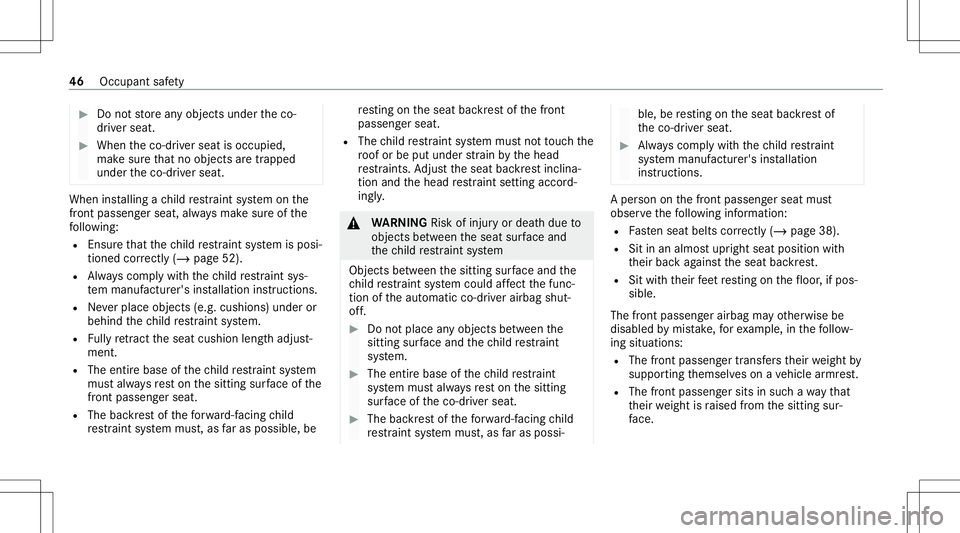
#
Donotst or ean yobject sunder theco-
dr iver seat. #
When theco- driver seat isoccupied,
mak esur eth at no obj ect sar etrapped
unde rth eco- driver seat. When
installing ach ild restra int system onthe
fr ont passeng ersea t,alw aysmak esur eof the
fo llo wing:
R Ensur eth at thech ild restra int system isposi‐
tion edcor rectl y(/ page 52).
R Alw ayscom plywithth ech ild restra int sys‐
te m manuf acturer'sinstallation instruct ions .
R Neverpla ceobjects (e.g.cushi ons)under or
behi ndthech ild restra int system.
R Fully re tract theseat cushion lengthadjus t‐
ment .
R The entire base ofthech ild restra int system
mus talw aysre st on thesitt ing surface ofthe
fr ont passeng ersea t.
R The backres tof thefo rw ard-f acin gch ild
re stra int system mus t,as faras possi ble,be re
sting ontheseat backres tof thefront
passeng erseat.
R The child restra int system mus tno tto uc hth e
ro of or be put under stra in by thehead
re stra int s.Ad jus tth eseat backres tinclin a‐
tion andthehead restra int setting accord‐
ing ly. &
WARNIN GRisk ofinju ryor deat hdue to
object sbe tween theseat surface and
th ech ild restra int system
Objec tsbetween thesitt ing surface and the
ch ild restra int system could affect thefunc ‐
tion oftheaut omatic co-driver airbag shut‐
of f. #
Donotplace anyobjec tsbetween the
sitting surface and thech ild restra int
sy stem. #
The entire base ofthech ild restra int
sy stem mus talw aysre st on thesitt ing
sur face oftheco- driver seat. #
The backres tof thefo rw ard-f acin gch ild
re stra int system mus t,as faras possi ‐ ble,
beresting ontheseat backres tof
th eco- driver seat. #
Alw ayscom plywit hth ech ild restra int
sy stem manuf acturer'sinstallation
ins truct ions . A
per son onthefront passeng erseat must
obser vethefo llo wing informatio n:
R Fasten seat belts correctl y(/ page 38).
R Sitinan almos tupr ight seatposi tion with
th eir bac kag ains tth eseat backres t.
R Sitwithth eir feet resting onthefloor ,if pos‐
sible.
The front passeng erairbag mayot her wise be
disable dby mis take ,fo rex am ple, inthefo llo w‐
ing situat ions:
R The front passen gertr ansf ersth eir weight by
suppor tingthemselv eson ave hicle armr est.
R The front passeng ersits insuc hawa yth at
th eir weight israised from thesitt ing sur‐
fa ce. 46
Occup antsafety
Page 55 of 430
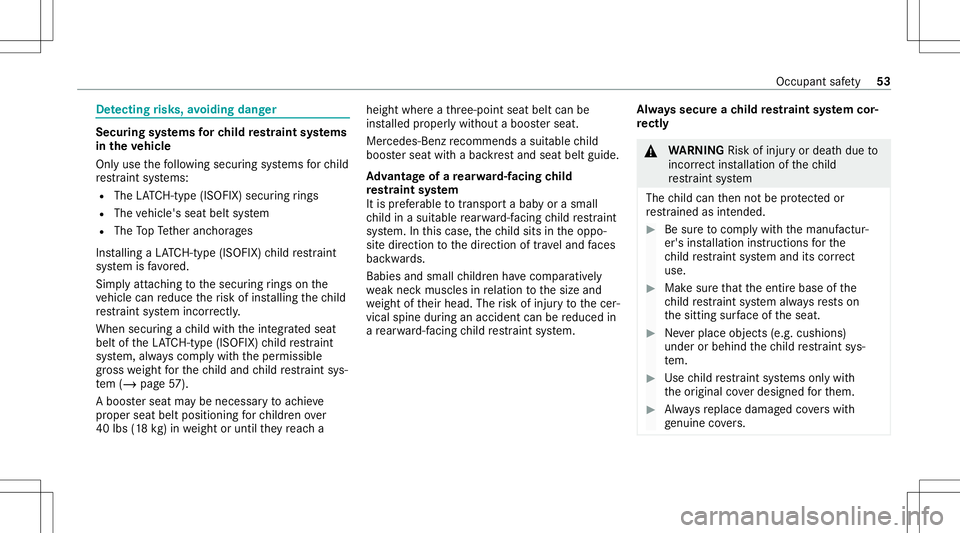
De
tectin grisk s,avo iding danger Secur
ingsystems forch ild restra int systems
in theve hicl e
Only usethefo llo wing secur ingsystems forch ild
re stra int systems:
R The LATC H-type (ISOFIX )secu ring rings
R The vehicle's seatbeltsystem
R The TopTe ther anc horages
Ins talling aLA TC H-type (ISOFIX )ch ild restra int
sy stem isfavo red.
Sim plyatta ching tothesecur ingrings onthe
ve hicle canreduce therisk ofins talling thech ild
re stra int system incor rectly .
Whe nsecu ring ach ild withth eint egr ated seat
belt oftheLA TC H-type (ISOFIX )ch ild restra int
sy stem, alwayscom plywithth eper missible
gr oss weight forth ech ild and child restra int sys‐
te m (/ page57 ).
A boos terseat maybe necessar yto achie ve
pr oper seatbeltposition ingforch ildr enove r
40 lbs (18 kg )in we ight orunt ilth ey reac ha heigh
twher eath re e-point seatbeltcanbe
ins talled proper lywit hout aboos terseat.
Mer cedes-Benz recomme ndsasu itab lech ild
boos terseat withabac kres tand seat beltguide.
Ad vantag eof are ar wa rd-faci ng child
re stra int system
It is prefer able totrans portabab yor asmall
ch ild inasuit able rear wa rd-faci ng child restra int
sy stem. Inthis case, thech ild sits intheoppo‐
sit edir ect ion tothedir ect ion oftrav el and faces
ba ckwa rds.
Babies andsmall childr enhave com parativ ely
we ak nec kmusc lesinrelation tothesize and
we ight oftheir head. Therisk ofinjur yto thecer‐
vical spine during anacciden tcan bereduced in
a re ar wa rd-faci ng child restra int system. Alw
ayssecur each ild restra int system cor‐
re ctl y &
WARNIN GRisk ofinju ryor deat hdue to
inc orrect ins tallation ofthech ild
re stra int system
The child can then notbe protect edor
re stra ined asintended . #
Besureto com plywith themanuf actur‐
er's installation instruct ions forth e
ch ild restra int system and itscor rect
us e. #
Makesur eth at theent ire base ofthe
ch ild restra int system alwaysre stson
th esitt ing surface oftheseat. #
Neverpla ceobjects (e.g.cushi ons)
under orbehi ndthech ild restra int sys‐
te m. #
Use child restra int systems onlywit h
th eor iginal coverdesi gned forth em. #
Alw aysre place damag edcovers wit h
ge nui ne covers. Occupant
safety 53
Page 102 of 430
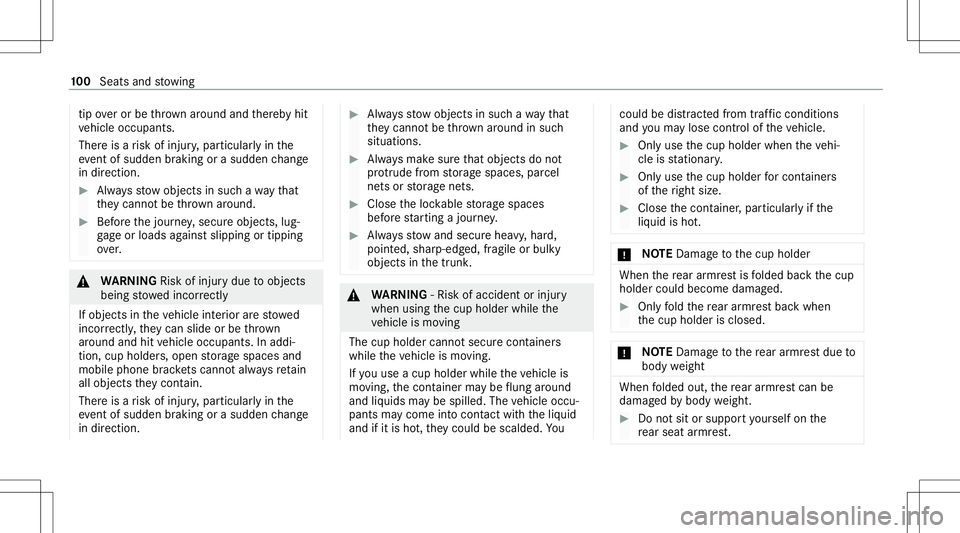
tip
ove ror be throw nar ou nd and ther eb yhit
ve hicle occupants.
Ther eis arisk ofinjur y,par ticular lyin the
ev ent ofsudden braking orasudden chang e
in dir ect ion. #
Alw aysst ow object sin suc hawa yth at
th ey canno tbe thro wn around . #
Beforeth ejour ney,secur eobjects, lug‐
ga ge orloads agains tslipping ortipping
ove r. &
WARNIN GRisk ofinju rydue toobject s
being stowe dincor rectl y
If obje ctsintheve hicle interior arestowe d
inc orrectly ,th ey can slide orbe throw n
ar oun dand hitvehicle occupants. Inaddi‐
tion, cupholder s,open stor ag espaces and
mobile phonebrac kets cann otalw aysre tain
all obje ctsth ey cont ain.
The reisarisk ofinjur y,par ticular lyin the
ev ent ofsudden braking orasudden chang e
in dir ect ion. #
Alw aysst ow object sin suc hawa yth at
th ey canno tbe thro wn around insuc h
sit uation s. #
Alw aysmak esur eth at obj ect sdo not
pr otru de from stor ag espaces, parcel
ne ts or stor ag ene ts. #
Close theloc kable stor ag espaces
bef orest ar tin gajo ur ne y. #
Alw aysst ow and securehea vy,har d,
poin ted, shar p-edg ed,fragile orbulky
objec tsinthetrunk . &
WARNIN G‑Ri sk ofacci dent orinju ry
when usingthecup holder whilethe
ve hicle ismo ving
The cup holder cannotsecur econt ainer s
while theve hicle ismo ving.
If yo uuse acup hold erwhile theve hicle is
mo ving, thecon tainer maybe flung aroun d
and liquids maybe spill ed.The vehicle occu‐
pants maycome intocont actwithth eliq uid
and ifit is ho t,th ey cou ldbe scal ded.Yo u cou
ldbe dist ra cted from traf fic condi tions
and youma ylose contro lof theve hicle. #
Onlyuse thecup holder whentheve hi‐
cle isstatio nary. #
Onlyuse thecup holder forcont ainer s
of theright size. #
Close thecon tainer ,par ticular lyifth e
liq uid isho t. *
NO
TEDama getothecup holder When
there ar armr estis folded backth ecup
holder couldbecome damaged. #
Onlyfo ld there ar armr estbac kwhen
th ecup holder isclosed. *
NO
TEDama getothere ar armr estdue to
body weight When
folded out,there ar armr estcan be
damag edbybody weight . #
Donotsit orsuppor tyo urself onthe
re ar seat armr est. 10
0
Sea tsand stow ing
Page 103 of 430

&
WARNIN G‑Ri sk offire and injuryfrom
ho tcig arette light er
Yo ucan burnyo urself ifyo uto uc hth eho t
heating element orthesoc ketof thecig a‐
re tte light er.
In additio n,flammab lemat erials mayign ite
if:
R youdr op theho tcig arette light er
R ach ild holds theho tcig arette light erto
object s,forex am ple #
Alw ayshold thecig arette light erby the
knob . #
Alw aysmak esur eth at thecig arette
light erisout ofreac hof childr en. #
Neverlea vechildr enunat tende din the
ve hicle. &
WARNIN GRisk ofburnsfrom theta il‐
pipe andtailpipe trims
The exhaus tta ilpipe andtailpipe trims can
becom eve ry hot.Ifyo uco me intoco ntact wit
hth ese partsof theve hicle, youco uld
bur nyo urself . #
Alw aysbe par ticular lycareful arou nd
th eta ilpipe andtheta ilpipe trims and
super visechildr enespec iallycloselyin
th is area. #
Allo wvehicle partsto cool down before
to uc hin gth em. The
driving charact eristic sof your vehicle are
dependent onthedis tribution oftheload within
th eve hicle. Yousho uld bear thefo llo wing in
min dwhen loading theve hicle:
R Neverex ceed theper missible gross mass or
th egr oss axle weight rating forth eve hicle
(including occupants). Thevalues arespec i‐
fi ed on theve hicle identif ication plateon the
ve hicle's B-pillar.
R The load mustno tpr otru de abo vetheupper
edg eof theseat backres ts.
R Alw aysplace theload behind unoccupied
seats ifpossible.
R Secur eth eload using thetie-do wneyes and
dis tribut eth eload evenly. St
ow agespace sin theve hicl eint erior Ov
ervie wof thefront storage com partmen ts 1
Stor ag espace inthedoor s
2 Stor ag ecom partmen tin thear mr estwit ha
multimedia andUSB connect ion
3 Stor ag ecom partmen tin thefront cent er
con sole withaUSB port
4 Glovebox Seats
andstow ing 10
1
Page 285 of 430
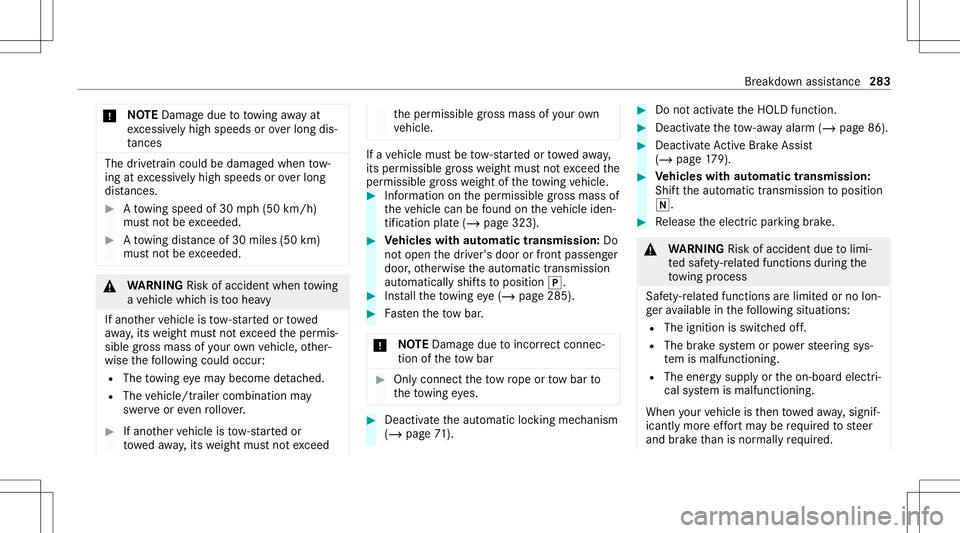
*
NO
TEDama gedue totowing away at
exc essiv elyhigh speeds orove rlong dis‐
ta nces The
drivet ra in could bedamag edwhen tow‐
ing atexc essiv elyhigh speeds orover long
dis tances. #
Atowing speed of30 mph(50 km/h)
mus tno tbe exc eeded. #
Atowing distan ceof30 miles(50 km)
mus tno tbe exc eeded. &
WARNIN GRisk ofacci dent whento wing
a ve hicle whichis toohea vy
If ano ther vehicle istow- star tedor towe d
aw ay,its weight mustno texc eed theper mis‐
sible gross mass ofyour ow nve hicle, other‐
wise thefo llo wing could occur:
R The towing eyema ybecome detach ed.
R The vehicle/tr ailercombination may
sw erve oreve nro llo ver. #
Ifano ther vehicle istow- star tedor
to we daw ay,its weight mustno texc eed th
eper missible gross mass ofyour ow n
ve hicle. If
ave hicle mustbe tow- star tedor towe daw ay,
its per missib legross weight mustno texc eed the
per missible gross weight oftheto wing vehicle. #
Information ontheper missible gross mass of
th eve hicle canbefound ontheve hicle iden‐
tif ication plate(/ page323). #
Vehicl eswith automatic transmiss ion:Do
no topen thedr iver's door orfront passeng er
door ,ot her wise theaut omatic transmiss ion
aut omaticall yshif tsto position 005D. #
Installth eto wing eye(/ page285). #
Fasten theto w bar .
* NO
TEDama gedue toinc orrect connec‐
tion oftheto w bar #
Onlyconnect theto w rope ortow bar to
th eto wing eyes. #
Deact ivat eth eaut omatic locking mechanism
(/ page71 ). #
Donotactiv ateth eHOLD function. #
Deact ivat eth eto w- aw ay alar m(/ page86) . #
Deact ivat eAc tiveBr ak eAssi st
( / pag e17 9). #
Vehicl eswith automatic transmiss ion:
Shif tth eaut omatic transmiss iontoposition
005C. #
Release theelectr icpar king brak e. &
WARNIN GRisk ofacci dent dueto limi‐
te dsaf ety-re lat ed func tionsdur ing the
to wing proce ss
Saf ety-re lat ed func tionsar elimit edorno lon‐
ge rav ailable inthefo llo wing situat ions:
R The ignit ionisswitc hedoff.
R The brak esy stem orpowe rst eer ing sys‐
te m ismalfu nctioning.
R The ener gysupp lyor theon- boar delectr i‐
cal system ismalfunct ioning.
When your vehicle isthen towe daw ay,signif ‐
icant lymor eef fort ma ybe requ ired tosteer
and brak eth an isno rm allyre qu ired. Br
eakdo wnassis tance 28
3
Page 300 of 430
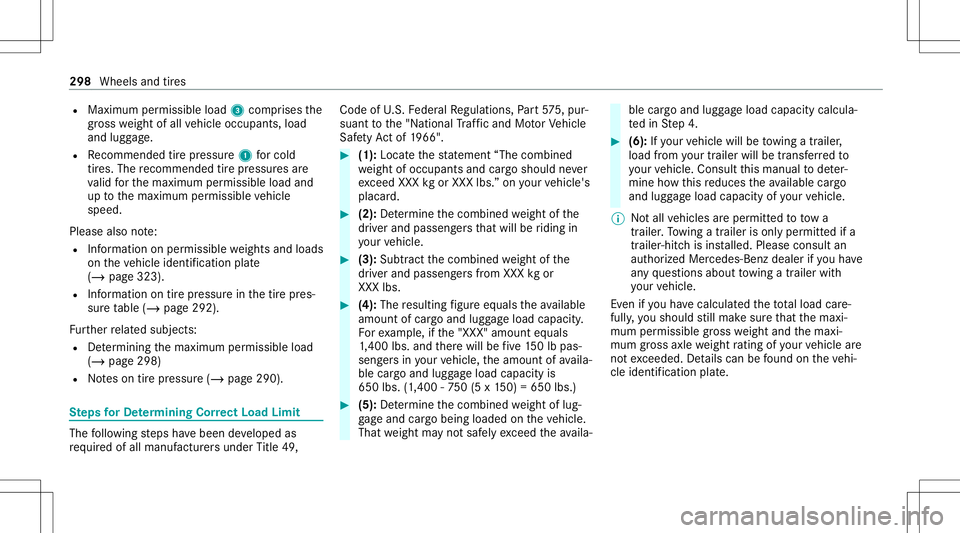
R
Maximum permissible load3com prises the
gr os swe ight ofall vehicle occupants, load
and luggage.
R Recomme ndedtirepr ess ure 1forcold
tir es. The recomme ndedtirepr ess ures are
va lid forth emaximum permissible loadand
up tothemaximum permissible vehicle
speed.
Please alsonote:
R Information onper missib lewe ight sand loads
on theve hicle identif ication plate
(/ page323).
R Information ontirepr essur ein thetir epr es‐
sur eta ble (/ page292).
Fu rther relat ed subje cts:
R Determ inin gth emaximum permissible load
(/ page298)
R Noteson tirepr essur e(/ page290). Ste
psforDe term ining Correct Load Limit The
follo wing steps have been developed as
re qu ired ofall manuf acturersunder Title 49, Co
de ofU.S. Feder alRe gulations, Part57 5, pur‐
sua nttothe"N ational Traf fic and MotorVe hicle
Saf etyAc tof 1966". #
(1):Locat eth est at emen t“T he combined
we ight ofocc upant sand cargoshould never
exc eed XXX kgorXXX lbs.”on your vehicle's
placar d. #
(2): Determ ine thecombin edweight ofthe
dr iver and passeng ersth at will beriding in
yo ur vehicle. #
(3): Subtr actthecombin edweight ofthe
dr iver and passeng ersfrom XXX kgor
XXX lbs. #
(4): The resulting figur eeq uals theav ailable
amoun tof car goand luggageload capac ity.
Fo rex am ple, ifth e"XXX" amount equals
1, 400 lbs.and ther ewill befive 150lb pas ‐
seng ersin your vehicle, theamount ofavaila‐
ble cargoand luggageload capac ityis
65 0lbs. (1,40 0-75 0(5 x15 0) =650 lbs.) #
(5):De term ine thecombin edweight oflug‐
ga ge and cargobein gloaded ontheve hicle.
That weight mayno tsaf elyexc eed theav aila‐ ble
cargoand luggageload capac itycalc ula‐
te din Step 4. #
(6): Ifyo ur vehicle willbetowing atrailer ,
load from your trailer willbetrans ferred to
yo ur vehicle. Consult this manual todeter‐
mine howthis reduces theav ailable cargo
and luggageload capac ityofyour vehicle.
% Notall vehicles areper mitt edtotow a
trailer .To wing atrailer isonl yper mittedifa
tra iler -hit chisins talled. Please consult an
aut hor ized Mercedes -Benz dealer ifyo uha ve
an yqu estion sabout towing atrailer with
yo ur vehicle.
Ev en ifyo uha ve cal cul ated thetot alload care‐
full y,yo usho uld still mak esur eth at themaxi‐
mum permissible gross weight andthemaxi‐
mum gross axle weight rating ofyour vehicle are
no texc eeded. Details can befound ontheve hi‐
cle identif ication plate. 298
Wheels andtires
Page 301 of 430
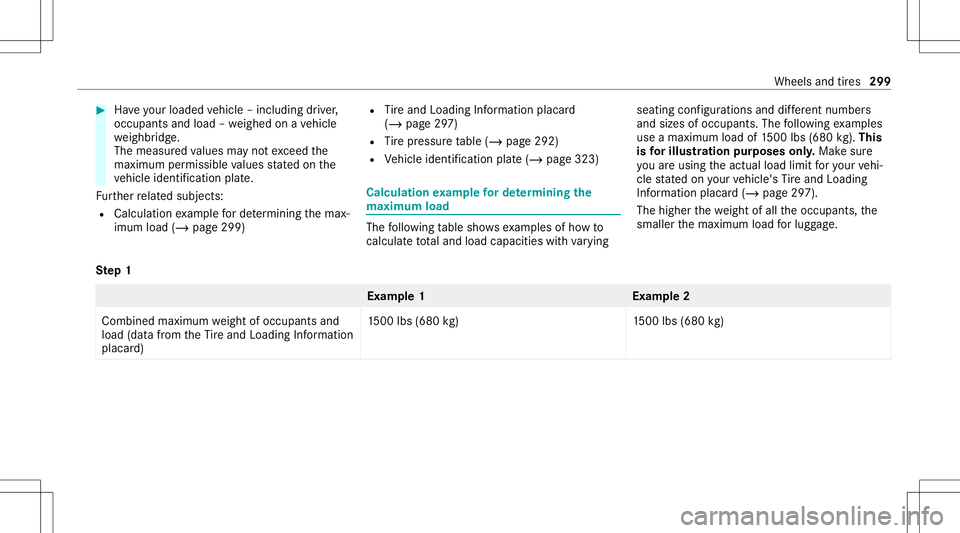
#
Have your loaded vehicle –including driver ,
occupants andload –we ighed onave hicle
we ighbr idge.
The measur edvalues mayno texc eed the
maximu mper missi blevalues stat ed on the
ve hicle identif ication plate.
Fu rther relat ed subje cts:
R Calculation exam ple forde term inin gth emax‐
imum load(/page299) R
Tire and Loadi ngInfo rm atio nplacar d
(/ page29 7)
R Tire pressur eta ble (/ page292)
R Vehicle identif ication plate(/ page323) Calculation
exam ple forde term ining the
ma ximum load The
follo wing table showsexam ples ofhowto
cal cul atetot aland load capac ities wit hva rying seatin
gcon figur ations anddiffere nt num bers
and sizes ofocc upant s.The follo wing exam ples
use amax imum loadof1500 lbs (680 kg).This
is forillus tratio npur pos esonly.Mak esur e
yo uar eusin gth eactual loadlimit foryo ur vehi‐
cle stat ed on your vehicle's Tire and Loadi ng
In fo rm atio nplacar d(/ page29 7).
The high erthewe ight ofall theoccupant s,the
smaller themaximum loadforlug gage .
Ste p1 Ex
am ple 1E xamp le2
Combine dmaxim umweight ofocc upant sand
load (datafrom theTire and Loadi ngInfo rm atio n
placar d) 15
00 lbs (680 kg)1 500lbs(680 kg) Wheels
andtires 299
Page 302 of 430
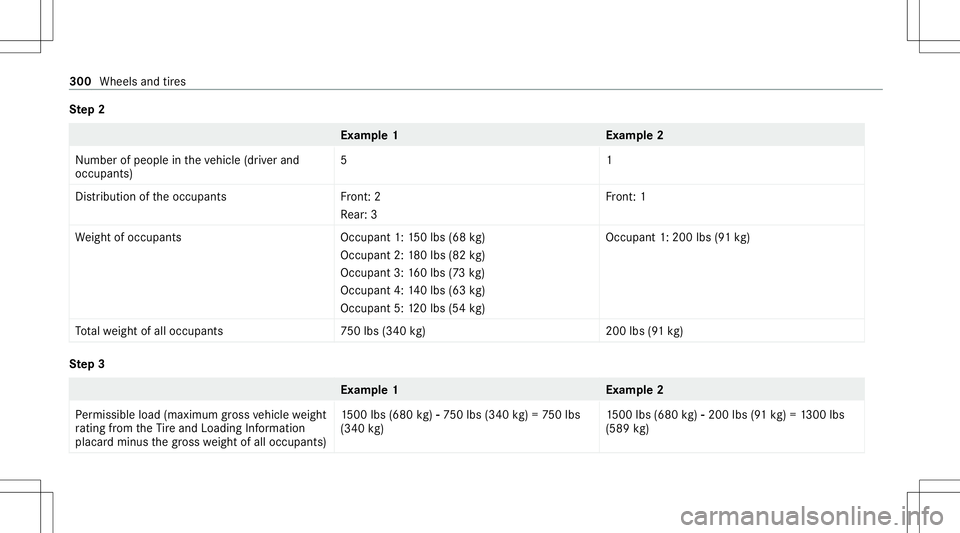
Ste
p2 Ex
am ple 1E xamp le2
Nu mb erofpeople intheve hicle (driver and
occupants) 51
Dis trib uti on oftheoccupant sF ront:2
Re ar:3 Fr
ont :1
We ight ofocc upant sO ccupant1:150lbs (68 kg)
Occupant 2:180lbs (82 kg)
Occupant 3:160lbs (73 kg )
Occupant 4:140lbs (63 kg)
Occupant 5:120lbs (54kg ) Occupant
1:200 lbs(91 kg )
To talwe ight ofall occ upant s7 50lbs (340 kg)2 00lbs (91 kg ) Ste
p3 Ex
am ple 1E xamp le2
Pe rm issible load(maxim umgros sve hicle weight
ra ting from theTire and Loadi ngInfo rm atio n
placar dmin usthegr oss weight ofall occ upant s)15
00 lbs (680 kg)00F8 75 0lbs (340 kg)= 75 0lbs
(340 kg) 15
00 lbs (680 kg)00F8 200 lbs(91 kg )= 13 00 lbs
(589 kg) 300
Wheels andtires